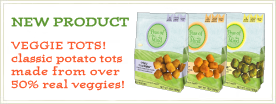Peas staff writer: Tina Downey
When in a great hippie market, I'm always on the lookout for anything new in the produce department. Should I find an item I've never cooked before, I'll buy it, research it at home, and (excitedly) learn how to cook it.
Delicious!
My favorite such (newly-discovered) vegetable is certainly the sunchoke. I had read marvelous things about sunchokes, namely about their deliciously delicate, artichoke-like flavor, but hadn't managed to find them before. "How exotic!" I thought as I bagged a few.
Native to North America
Turns out, sunchokes are a type of sunflower native to North America. (Native Americans began cultivating them for ages!) Sunchokes look a lot like ginger root but have a mild, sweet, nutty flavor reminiscent of artichokes, hence their nickname, the "Jerusalem Artichoke." (No relation to actual artichokes.)
Excellent Source of Iron
Sunchokes are extremely rich in iron, containing almost as much as meat! Sunchokes provide three times as much iron as an equal amount of broccoli. The skin of a sunchoke is edible and contains a large fraction of their nutrients, so its best to leave their skin on and simply scrub them clean. Sunchokes lend themselves to a variety of cooking methods. Though they can be eaten raw or cooked, they really shine as a refreshing stand-in for potatoes (prepared any way you'd cook potatoes.)
Great Winter Vegetable
Sunchokes are available year round, but they're most available (and most delicious) from late Fall into the Spring! In fact, from what I read in an old gardening book, sunchokes are dead simple to farm; they have freakishly low nutrient requirements (from soil) and they produce compounds that naturally provide an anti-freezing effect, making them quite hearty throughout the winter.
Unfortunately Expensive
Being that sunchokes are not only native to the US but also ridiculously simple to grow, why on earth are they so darn expensive? ($5.99/lb at my local market!) Now there's an investment opportunity; "Root vegetable grows like a weed and commands $6/lb price tag!" Hopefully, as sunchokes make their way onto more trendy restaurant menus, the buzz will lead more farmers to grow them, and an increased availability will lead to affordability.
Until then, I'll buy sunchokes occasionally when I'm out to impress foodie friends with my best guess at the next hot (food) thing!



